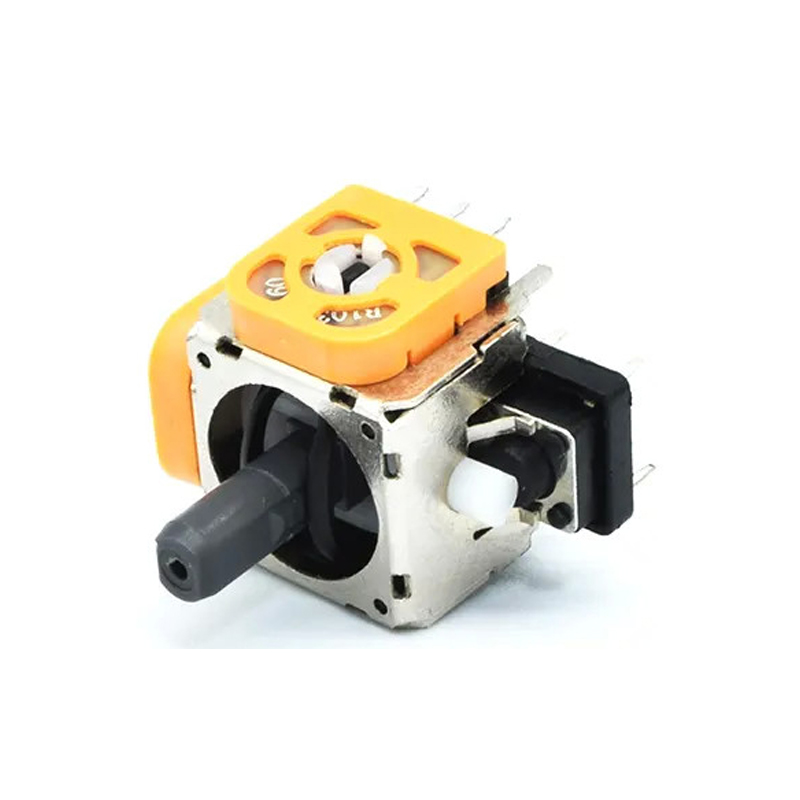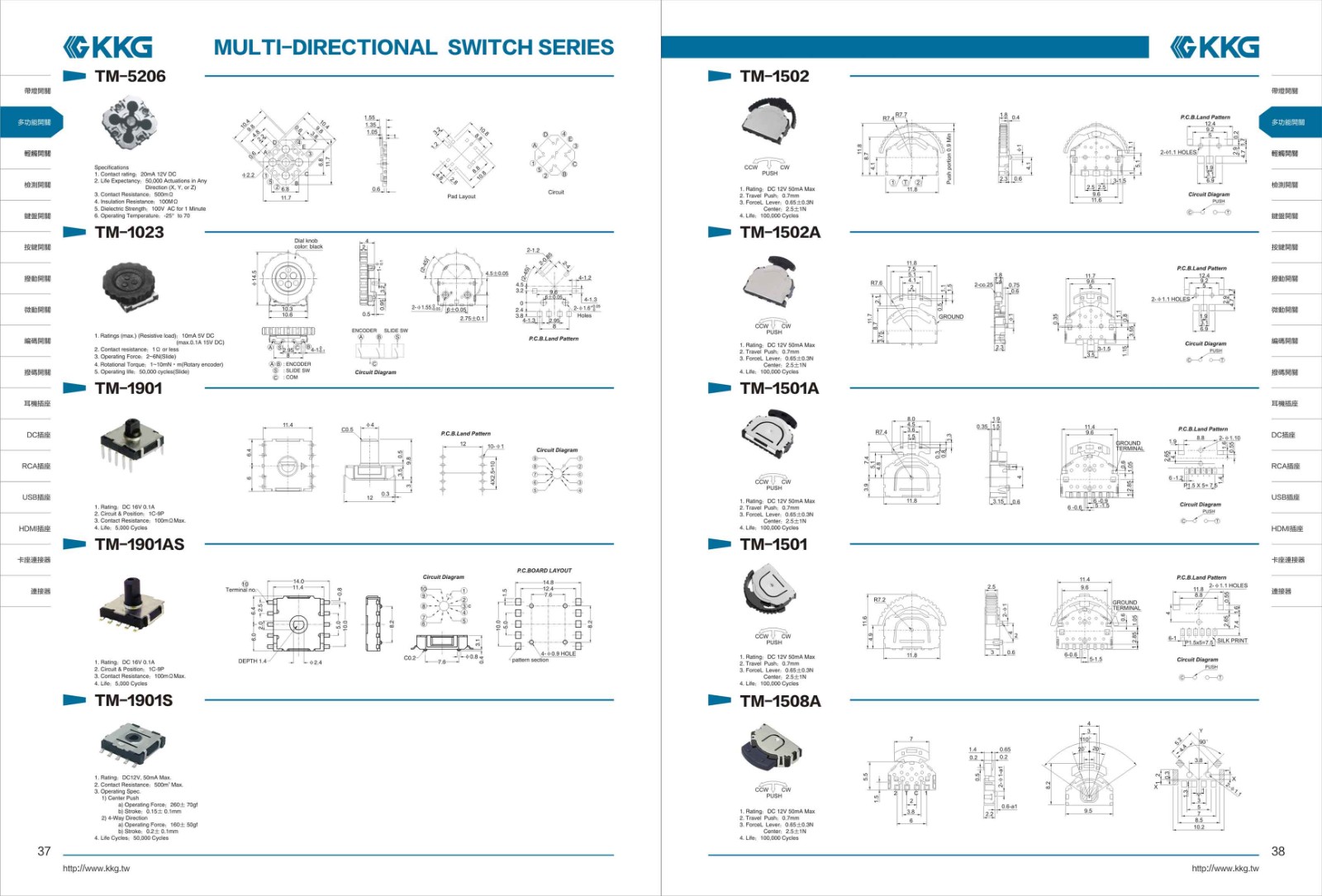





A joystick potentiometer is an electromechanical input device combining a manual control stick with one or more variable resistors (potentiometers). Tilting the stick in different directions mechanically adjusts the potentiometers, producing proportional analog voltage signals. These signals correspond to the stick's precise X and Y-axis (and sometimes Z-axis) position. This component is fundamental in applications like RC controllers, industrial machinery, gaming peripherals, and robotics, providing intuitive and precise directional or speed control. Its analog nature allows for smooth, variable movement input rather than simple on/off commands.
| Place Of Origin | Guangdong, China | Model Number | KKG- RJ16 |
| D/C | RJ16 | Resistance | 5K-2M |
| Rated Power | 0.15W | Operating Temperature | -20°C To +70°C |
| Power (Watts) | 0.1 | Adjustment Type | Top Adjustment |
| Length | Standard | Termination | Pin |
| Built In Switch | None | Rotation | 300° |
| Termination Style | PC Pin | Actuator Length | Standard |
| Bushing Thread | M7 | Number Of Turns | 10000 Cycles |
| Product Name | 16mm Rotary Potentiometer | Keywords | Volume Control 10k Linear Potentiometer |
| Appliance | Electronic Games | Key Words | Rotary Potentiometer 10K 50K 100K |
| Delivery Time | 15-30 Days | Type | Rotary Potentiometer |
| Technology | Carbon Film | Resistance Tolerance | ±20%(more Than 1MΩ±30%) |
| Max. Operating Voltage | 200V AC | Brand | Rotary Potentiometer |
| Packaging | Standard | Tolerance | ±10% |
| Diameter | 24mm | Mounting Type | Insert |
| Package / Case | Metal | Temperature Coefficient | 0.05 |
| Resistive Material | Carbon | Actuator Type | Knob |
| Actuator Diameter | Not Applicable | Shaft Size | Not Applicable |
| Cross Reference | ALPHA | Service | OEM ODM |
| Key Words 2 | Dual Potentiometer Switch | Shaft Type | Plastic |
| Certification | CE ISO9001 | Package | Carton |
Solid potentiometer is made of carbon black, graphite, quartz powder, organic adhesives and other materials prepared by the intermingling of heating, pressed on the plastic substrate, and then heated polymerization.
| Electrical Specification | |
| Total Resistane | 10KΩ~ 100kΩ |
| Total Resistance Tolerance | ±20% |
| Resistance Taper | B, See P128 |
| Max. Operation Voltage | Liner Taper B:AC50V or DC5.0V |
| Rated Power | liner taper B:0.0125W |
| Sliding Noise | Less than 300mV (by JIS method) |
| Insulation resistance | more than 100MΩ at DC250V 1Minute |
| Withstand Voltage | 1 minute at AC 250V/2mV/50Hz |
| Operating Life | 100,000 cycles min |
| contact resistance | less than 300MΩ |
| insulation resistance | more than 100MΩ |
| withstand voltage | 1 minute at AC 250V (50-60HZ) |
| Travel | 0.25+0.2/0.1mm |
| Operating force | 480±150gf |
| Durability | |
| Operating life | 100,000 cycles Min |
| Mechanical specification | |
| Figure of lever operation | Circular Operating |
| Stopper strength | 3.1 kgf.cm Min 3 sec |
| Push-Pull strength | Push/Pull 5.0 kgf Min 3 sec |
| Operation force | 300 gf.cm Max. |
| Accuracy of rest position | ±5° |
| Operating angle of lever | 55 ±6° |
| Tact Switch specification | |
| Maximum Ratings | 12V DC 50mA |
| Operating Force | 820±260gf |
| Travel | 0.5+0.5 -0.4mm |
Since the rocker potentiometer is used as a control device, the basic characteristics needed is to have a
strong operability, to meet the user's accurate control, while in the process of manipulation, smooth enough
to quickly reset, a good experience, to enhance the user's operating effect.
The use of high quality materials and strict control of each process produced by the rocker potentiometer,
in order to effectively improve the service life, to achieve stable quality and durability.
Although the potentiometer is mainly used in some electronic toys and handles, but different industries will
produce a variety of different products, need to meet the adaptability, in order to facilitate the purchase and
use of such products are more practical, strong utilization rate, can be the subsequent production use.
Joystick potentiometers, which translate physical lever movement into variable electrical resistance, are fundamental components in numerous industries. Their ability to provide precise, proportional control in two or more axes makes them indispensable for a wide range of applications.
In factory and warehouse settings, joysticks with potentiometers are crucial for the precise control of machinery. They are commonly used to operate overhead cranes, industrial robots, and conveyor systems, allowing operators to manipulate heavy loads with fine-tuned speed and directional accuracy.
Heavy equipment such as excavators, forklifts, and aerial work platforms rely heavily on robust joystick potentiometers. These components enable operators to perform complex maneuvers, like lifting, digging, and positioning, with intuitive and responsive control, directly impacting productivity and safety on the job site.
From professional video editing consoles and audio mixing boards to high-end gaming controllers, joystick potentiometers provide essential analog input. They offer users smooth, variable control for tasks like panning a camera, adjusting faders, or controlling a character's movement speed.
The need for precise and reliable control is paramount in the medical field. Joystick potentiometers are integrated into powered wheelchairs, patient hoists, and surgical robotics. Their proportional output allows for gentle, accurate movements that are critical for patient care and complex medical procedures.
Within cockpits, specialized joystick potentiometers are used in various control interfaces. They can manage non-critical systems like cursor control on display units, menu navigation, or the adjustment of sensor gimbals, providing pilots with a reliable and tactile interface.


A: It's a variable resistor that translates joystick movement into electrical signals, controlling direction or intensity in devices like game controllers or industrial equipment.
A: Moving the joystick shifts internal wipers across resistive tracks, changing resistance values to produce corresponding voltage outputs for precise positional feedback.
A: They’re vital in gaming consoles, RC models, robotics, and medical joysticks, providing accurate motion control and durability.
A: Common variants include single-axis and dual-axis potentiometers, with options for linear or logarithmic response curves depending on the application.
A: Mechanical friction from repeated use degrades the resistive element over time, leading to "jittery" outputs or complete failure.
A: Yes, Hall effect sensors or optical encoders offer non-contact alternatives, enhancing longevity and precision in modern designs.
Previous: Joystick Potentiometer

Tel:
Add:
Rixing Industrial Zone,Tangxia Town, Dongguan City, Guangdong Province, China
Copyright © 2025 KKG ELECTRONICS ELECTRIC Co., LTD. All rights reserved
Privacy policy Cookie tracking